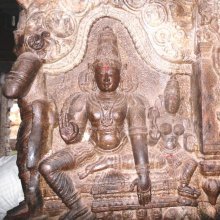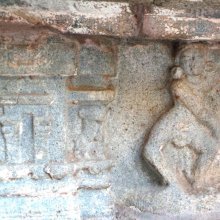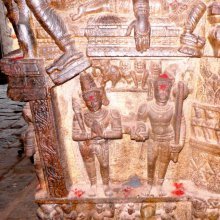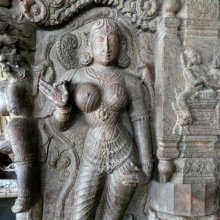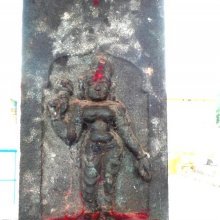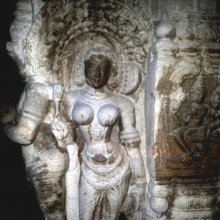Uras, Urash: 15 definitions
Introduction:
Uras means something in Hinduism, Sanskrit. If you want to know the exact meaning, history, etymology or English translation of this term then check out the descriptions on this page. Add your comment or reference to a book if you want to contribute to this summary article.
Images (photo gallery)
(+117 more images available)
In Hinduism
Natyashastra (theatrics and dramaturgy)
Source: Wisdom Library: Nāṭya-śāstra1) Uras (उरस्) refers to “breast”. It is one of the six major limbs (aṅga) used in dramatic performance, according to the Nāṭyaśāstra chapter 8. With these limbs are made the various gestures (āṅgika), which form a part of the histrionic representation (abhinaya).
There are five kinds of “gestures of the breast (uras)” defined:
- ābhugna (slightly bent),
- nirbhugna (unbent),
- prakampita (shaking),
- udvāhita (raised),
- sama (natural).
2) According to the Nāṭyaśāstra chapter 19 , uras, as the “chest”, refers to a type of ‘vocal representation’ (vācika), which is used in communicating the meaning of the drama and calling forth the sentiment (rasa). Accordingly, to call a person when he is at a short distance the voice should proceed from the chest (uras).

Natyashastra (नाट्यशास्त्र, nāṭyaśāstra) refers to both the ancient Indian tradition (shastra) of performing arts, (natya—theatrics, drama, dance, music), as well as the name of a Sanskrit work dealing with these subjects. It also teaches the rules for composing Dramatic plays (nataka), construction and performance of Theater, and Poetic works (kavya).
Shaivism (Shaiva philosophy)
Source: Brill: Śaivism and the Tantric TraditionsUras (उरस्) [=Uraska?] refers to the “chest”, according to the 13th-century Matsyendrasaṃhitā: a Kubjikā-Tripurā oriented Tantric Yoga text of the Ṣaḍanvayaśāmbhava tradition from South India.—Accordingly, “[Visualisation of Parameśvara]:—[...] He is in the prime of his youth and has all the auspicious characteristics. He has the great Ajagava bow placed on his left side. On his right, he has five glowing arrows. He is shining like a blue lotus. On his chest (uraska) there is a glittering garland of blue lotuses. He is the Lord. [...]”.

Shaiva (शैव, śaiva) or Shaivism (śaivism) represents a tradition of Hinduism worshiping Shiva as the supreme being. Closely related to Shaktism, Shaiva literature includes a range of scriptures, including Tantras, while the root of this tradition may be traced back to the ancient Vedas.
Gitashastra (science of music)
Source: Shodhganga: Elements of Art and Architecture in the Trtiyakhanda of the Visnudharmottarapurana (gita)Uras (उरस्, “chest”) refers to one of the three kinds of sthāna (the organs of utterance), according to the Viṣṇudharmottarapurāṇa, an ancient Sanskrit text which (being encyclopedic in nature) deals with a variety of cultural topics such as arts, architecture, music, grammar and astronomy.—During the practise of Vocal Music, the proper production of the concerned sound is always considered as very important. Sthāna or ucchāraṇasthāna is the place of articulation of sound. Bhattojidīkṣita in his Siddhāntakaumudī said about ten kinds of sthāna (i.e., the organs of utterance), e.g., uras (i.e., chest).
Gitashastra (गीतशास्त्र, gītaśāstra) refers to the ancient Indian science of Music (gita or samgita), which is traditionally divided in Vocal music, Instrumental music and Dance (under the jurisdiction of music). The different elements and technical terms are explained in a wide range of (often Sanskrit) literature.
Yoga (school of philosophy)
Source: ORA: Amanaska (king of all yogas): A Critical Edition and Annotated Translation by Jason BirchUras (उरस्) refers to the “chest”, according to the Mataṅgapārameśvaratantra (Mataṅgapārameśvara’s Yogapāda) verse 2.23-27.—Accordingly, while discussing ancillary and seated poses in Yoga: “[...] Having raised and broadened the chest (uras) and having made the arms loose, the wise [Yogin] should extend his back and raise the region of the shoulders. He should diligently hold the neck still, very steady and straight [but] not too rigid nor bent [to one side]. [...]”.

Yoga is originally considered a branch of Hindu philosophy (astika), but both ancient and modern Yoga combine the physical, mental and spiritual. Yoga teaches various physical techniques also known as āsanas (postures), used for various purposes (eg., meditation, contemplation, relaxation).
Purana and Itihasa (epic history)
Source: archive.org: Shiva Purana - English TranslationUras (उरस्) refers to the “breast” [?], according to the Śivapurāṇa 2.4.10 (“Boasting of Tāraka”).—Accordingly, as Tāraka-Asura fought with Kārttikeya: “[...] They were equally good adepts in fighting. Each wanted to kill the other. They utilised all their power. With the edges of spears they hit each other. They hit or cut each other’s head, neck, thighs, knees, hips, heart, chest and the back [vakṣasyurasi pṛṣṭhe ca]. They continued the fight swaggering and vaunting with heroic words. They were experts in different tactics of warfare. They were equally strong. They desired to kill each other. [...]”.

The Purana (पुराण, purāṇas) refers to Sanskrit literature preserving ancient India’s vast cultural history, including historical legends, religious ceremonies, various arts and sciences. The eighteen mahapuranas total over 400,000 shlokas (metrical couplets) and date to at least several centuries BCE.
Ayurveda (science of life)
Veterinary Medicine (The study and treatment of Animals)
Source: archive.org: The Elephant Lore of the HindusUras (उरस्) refers to the “breast” (of an elephant), according to the 15th century Mātaṅgalīlā composed by Nīlakaṇṭha in 263 Sanskrit verses, dealing with elephantology in ancient India, focusing on the science of management and treatment of elephants.—[Cf. chapter 5, “on marks of the stages of life”]: “4. With clearly developed nails, vidu, joints, ears, and sheaths and covering of the tusks; spotted on the breast (uras), and on the lobes of the ears [urasi sabinduḥ karṇapiñchūṣayośca]; hairy in the ears and on the head, with uplifted head, eating grass, with rather stout (firm) rows of teeth, in the third year he is an upasarpa”.

Āyurveda (आयुर्वेद, ayurveda) is a branch of Indian science dealing with medicine, herbalism, taxology, anatomy, surgery, alchemy and related topics. Traditional practice of Āyurveda in ancient India dates back to at least the first millenium BC. Literature is commonly written in Sanskrit using various poetic metres.
Languages of India and abroad
Sanskrit dictionary
Source: DDSA: The practical Sanskrit-English dictionaryUras (उरस्).—a. Best, excellent. n. (uraḥ) The breast, bosom; व्यूढोरस्को वृषस्कन्धः (vyūḍhorasko vṛṣaskandhaḥ) R.1.13; Kumārasambhava 6.51; उरसि कृ (urasi kṛ) to clasp to the bosom.
Source: Cologne Digital Sanskrit Dictionaries: Shabda-Sagara Sanskrit-English DictionaryUras (उरस्).—mfn.
(-rāḥ-rāḥ-raḥ) Best, excellent. n.
(-raḥ) The breast, the bosom. E. ṛ to go, Unadi affix asun, the pen. changed to u; also ura a Soutra root, to go, and asun as before.
Source: Cologne Digital Sanskrit Dictionaries: Benfey Sanskrit-English DictionaryUras (उरस्).—probably for varas, i. e. vṛ + as, and akin to uru, n. The breast, [Daśakumāracarita] in
Uras (उरस्).—[neuter] breast; adj. —° uraska.
Source: Cologne Digital Sanskrit Dictionaries: Monier-Williams Sanskrit-English Dictionary1) Uras (उरस्):—n. (√ṛ, [Uṇādi-sūtra iv, 194]), the chest, breast, bosom, [Ṛg-veda; Atharva-veda; Śatapatha-brāhmaṇa; Mahābhārata; Śakuntalā] etc. (urasi kṛtvā, or -kṛtya ind. having assented or adopted, but only urasi kṛtvā in the sense of having put upon the breast, [Pāṇini 1-4, 75])
2) the best of its kind, [cf. Lexicographers, esp. such as amarasiṃha, halāyudha, hemacandra, etc.]
3) m. Name of a man [gana] tikādi, [Pāṇini 4-1, 154] (in the [Kāśikā-vṛtti])
4) Uraś (उरश्):—[from uras] (in [compound] for uras above).
Source: Cologne Digital Sanskrit Dictionaries: Yates Sanskrit-English DictionaryUras (उरस्):—(raḥ) 5. n. The breast.
Source: DDSA: Paia-sadda-mahannavo; a comprehensive Prakrit Hindi dictionary (S)Uras (उरस्) in the Sanskrit language is related to the Prakrit word: Ura.
[Sanskrit to German]
Sanskrit, also spelled संस्कृतम् (saṃskṛtam), is an ancient language of India commonly seen as the grandmother of the Indo-European language family (even English!). Closely allied with Prakrit and Pali, Sanskrit is more exhaustive in both grammar and terms and has the most extensive collection of literature in the world, greatly surpassing its sister-languages Greek and Latin.
See also (Relevant definitions)
Starts with (+12): Urahkapata, Urahkata, Urahkritya, Urahkshata, Urahkshaya, Urahparshvardhamandali, Urahpesha, Urahstambha, Urahsthala, Urahsutrika, Urasa, Urasasprishtam, Urase, Urashchada, Urashi, Urasija, Urasikritya, Urasiloman, Urasiruha, Urassutra.
Query error!
Full-text (+79): Urashchada, Uroja, Urahsutrika, Urograha, Urastrana, Uroghata, Urastas, Urahkshata, Urahkshaya, Urobhushana, Uraska, Urastra, Urasvat, Urahstambha, Urahsthala, Urahkapata, Urasija, Urogamin, Uraga, Urasila.
Relevant text
Search found 38 books and stories containing Uras, Uraś, Urash; (plurals include: Urases, Uraśs, Urashes). You can also click to the full overview containing English textual excerpts. Below are direct links for the most relevant articles:
Bhakti-rasamrta-sindhu (by Śrīla Rūpa Gosvāmī)
Verse 2.1.321 < [Part 1 - Ecstatic Excitants (vibhāva)]
Verse 3.4.63 < [Part 4 - Parenthood (vātsalya-rasa)]
Nitiprakasika (Critical Analysis) (by S. Anusha)
Vyūhas—Composition < [Chapter 4]
The civilization of Babylonia and Assyria (by Morris Jastrow)
Part V < [Chapter IV - The Gods Of Babylonia And Assyria]
Part XVIII < [Chapter VI - Law And Commerce]
Part XII < [Chapter VI - Law And Commerce]
Marma-sastra and Ayurveda (study) (by C. Suresh Kumar)
Udara and Uras Marmas (introduction) < [Part 2 - Study of Marmas]
Study of Apalapa Marma < [Part 2 - Study of Marmas]
Brihat Jataka by Varahamihira [Sanskrit/English] (by Michael D Neely)
The Nervous System in Yoga and Tantra (Study) (by Ashok Majumdar)
10. The Five Vayus < [Chapter 7 - The Physiological and the Pathological concepts of Tridosha Theory]
12. The Five Kaphas < [Chapter 7 - The Physiological and the Pathological concepts of Tridosha Theory]
6. Location of Vayu, Pitta and Kapha in the normal body < [Chapter 7 - The Physiological and the Pathological concepts of Tridosha Theory]
